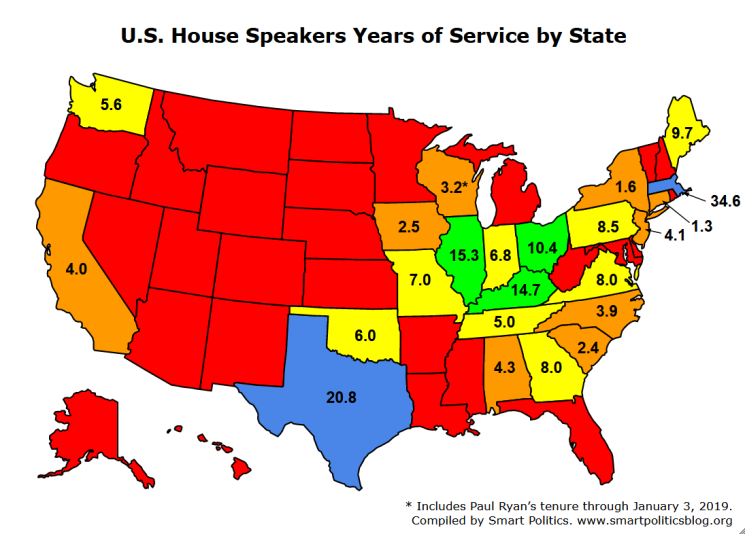A Review of US House Speakers by State
The 54 speakers in U.S. history have come from less than two-dozen states, with speakers from five states collectively accounting for more than half the time in office

Immediately after that news was leaked, speculation began that Majority Whip Steve Scalise of Louisiana’s 1st Congressional District would be favored to vie for Ryan’s office next January on the GOP side of the aisle.
Ryan is the first Wisconsinite to serve as speaker in the 229-year history of the legislative body and will end his tenure with 3 years, 2 months, 6 days on the job in January 2019.
Scalise is the only member of the Republican leadership who represents a district in a state that has not yet produced a House speaker: Majority Leader Kevin McCarthy of California, Conference Chair Cathy McMorris Rodgers of Washington, Conference Vice-Chair Doug Collins of Georgia, Conference Secretary Jason Smith of Missouri, Campaign Committee Chair Steve Stivers of Ohio, and Policy Committee Chair Luke Messer of Indiana (who is running for U.S. Senate this cycle).
Overall, 27 states have never produced a speaker – mostly from the West or sparsely populated states: Alaska, Arizona, Arkansas, Colorado, Delaware, Florida, Hawaii, Idaho, Kansas, Louisiana, Maryland, Michigan, Minnesota, Mississippi, Montana, Nebraska, Nevada, New Hampshire, New Mexico, North Dakota, Oregon, Rhode Island, South Dakota, Utah, Vermont, West Virginia, and Wyoming.
Twenty-two speakers have come from the South, with 18 from the Northeast, 12 from the Midwest, and just two from the West (Democrats Tom Foley of Washington and Nancy Pelosi of California).
Massachusetts by far leads the nation with the largest number of speakers in the history of the office with eight: Federalist Theodore Sedgwick (1799-1801), Jeffersonian Republican Joseph Varnum (1807-1811), Whig Robert Winthrop (1847-1849), the American Party’s Nathaniel Banks (1856-1857), Republican Frederick Gillett (1919-1925), Republican Joseph Martin (1947-1949; 1953-1955), Democrat John McCormack (1962-1971), and Democrat Tip O’Neill (1977-1987).
Kentucky and Virginia have each produced four speakers with three coming from Georgia, Illinois, Indiana, Ohio, Pennsylvania, Tennessee, and Texas.
Massachusetts U.S. Representatives also lead the country logging a collective 34.6 years as speaker over the decades. That amounts to 18.4 percent of the time the legislative body has been led by a speaker since 1789.
Texas is next at 20.8 years followed by Illinois (15.3), Kentucky (14.7), Ohio (10.4), Maine (9.7), and Pennsylvania (8.5).
Speakers from just five states – Massachusetts (18.4 percent), Texas (11.1 percent), Illinois (8.2 percent), Kentucky (7.8 percent), and Ohio (5.5 percent) – constitute more than half of the total time in office logged by the 54 speakers in U.S. history (95.8 of 187.7 years, or 51.0 percent). [Note: The sum total of House Speaker tenures is less than the number of years in which the legislative body has existed because elections for the position were frequently not held until late in the year until the 21st Century].
Speakers from southern states have led the chamber for 73.1 years with those from the Northeast at 59.8 years, the Midwest at 45.2 years, and the West at just 9.6 years.
Follow Smart Politics on Twitter.


Surely Majority Leader McCarthy is a member of the Republican House leadership?
Yes – thank you for catching that omission!
1. Even LA would more likely than not be without a speaker of its own come 2019 and 2020, for the chance of Scalise’s party retaining its majority after the ’18 midterm balloting seems to be no better than 50%. Well, at least the Pelican State seems on its way of producing its first US HR MINORITY LEADER, joining MI (Gerald Rudolph Ford) and some other states (also presumably not hailing from Western or sparsely populated states, with a few exceptions).
2. The surfeit of House speakers, along with their unmatched collective longevity, from MA is testament both to its large size and the highly competitive nature of its politics for much of the country’s history. Even today, the Bay State ranks in the top 2/5 of the most populous states, and has had R state governors since 1991, except for an 8-year interregnum (2007-2015), effectively providing a partial equipoise to its D dominance elsewhere – a phenomenon that seems likely to continue.